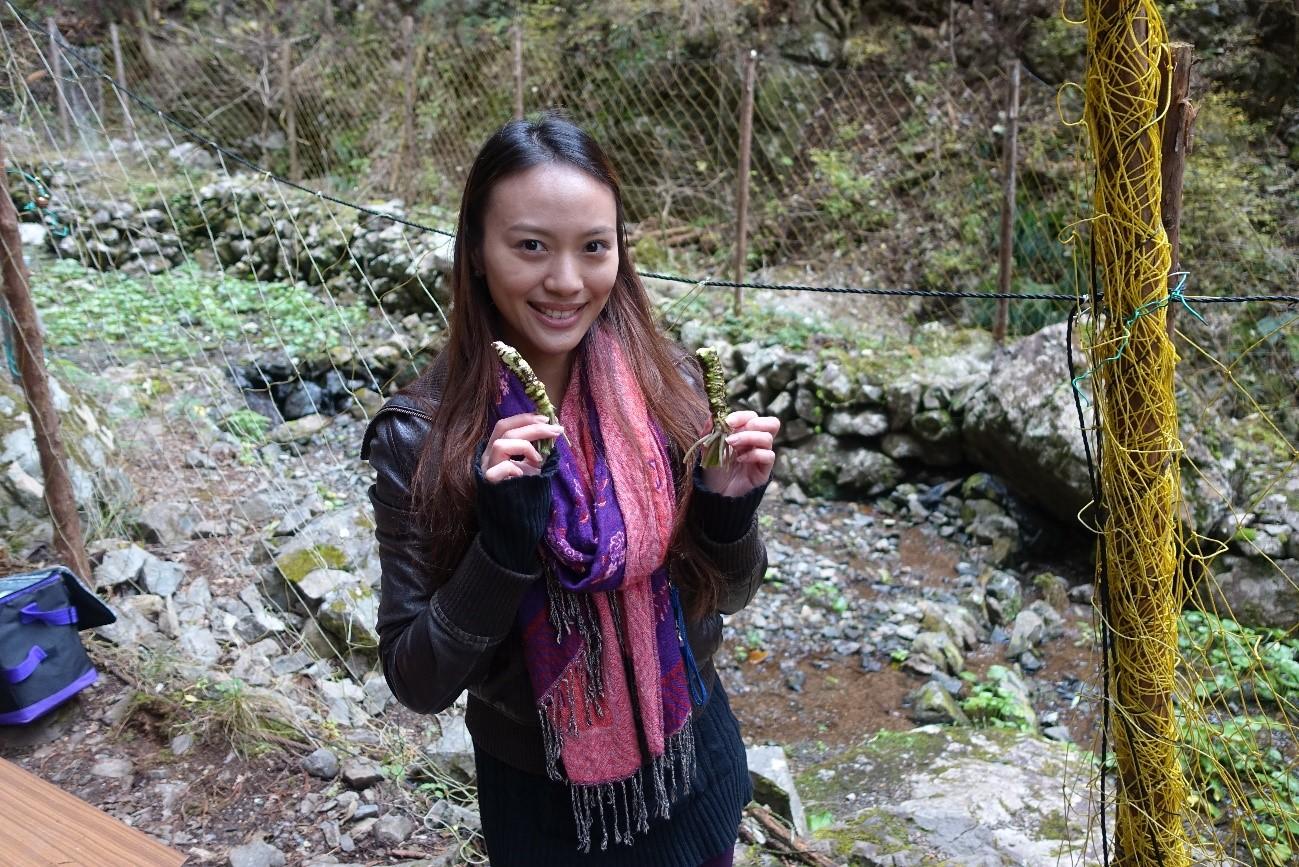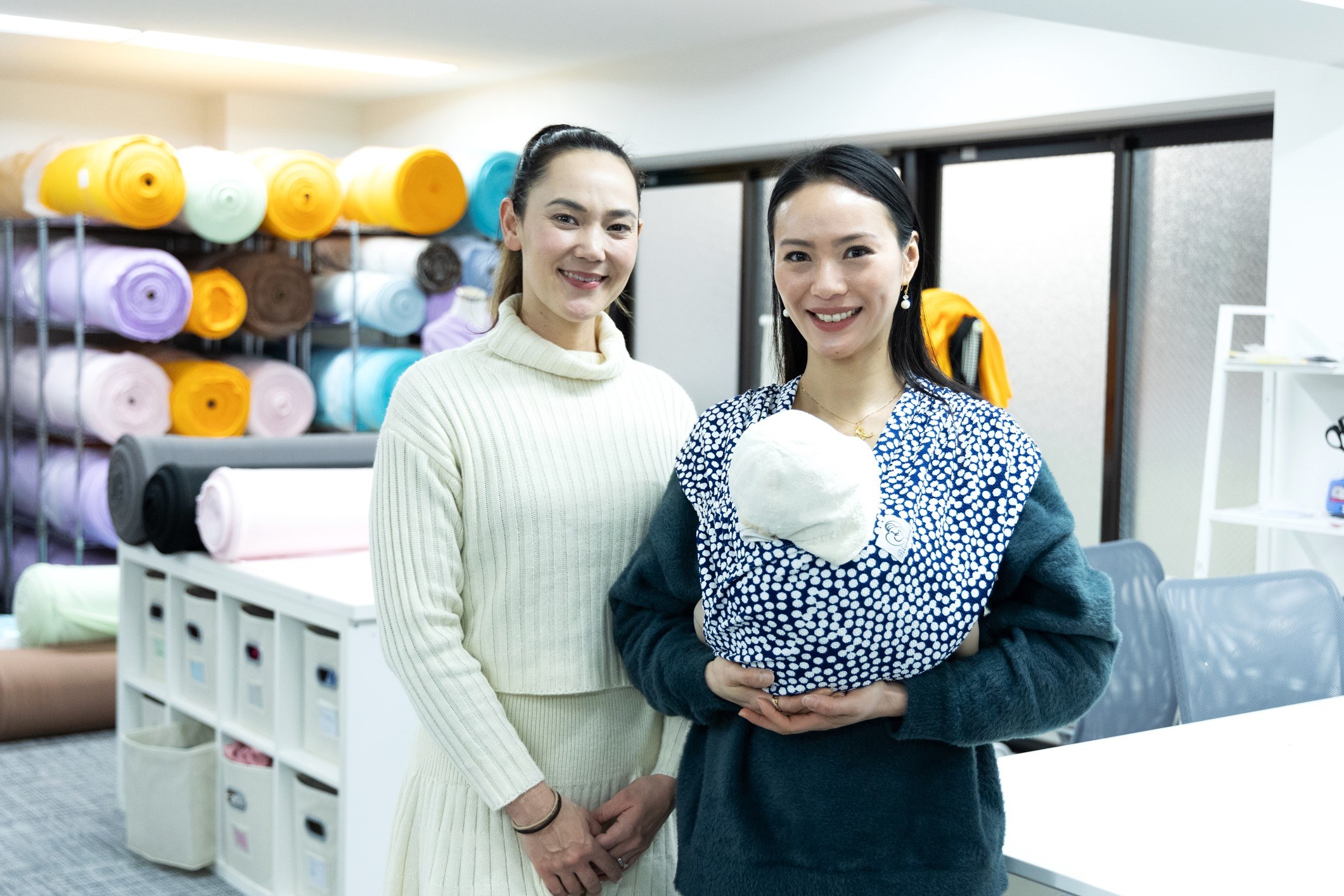On a day trip to Okutama (about an hour west of Shinjuku), I met with wasabi cultivator David Hulme, an Australian expat in Japan and former journalist who has been working hard to expand knowledge of wasabi growing while restoring an old wasabi patch!
奥多摩への日帰り旅行で、ワサビ栽培者David Hulmeさん(在日在住オーストラリア人の元記者)と出会いました!彼は古い山葵谷を復元するように成長しているワサビの知識を拡大するために懸命に働いています。
Join me for a tour of Wasabi Growing in Okutama followed by an exclusive Interview with Wasabi Cultivator David Hulme!
Let’s learn about wasabi growing together!
奥多摩で生育するわさびを見学するツアーを体験して、専門知識を教えてくれたDavidとの独占インタビューを行いました!ぜひご覧くださいね~
一緒にワサビについて学びましょう!
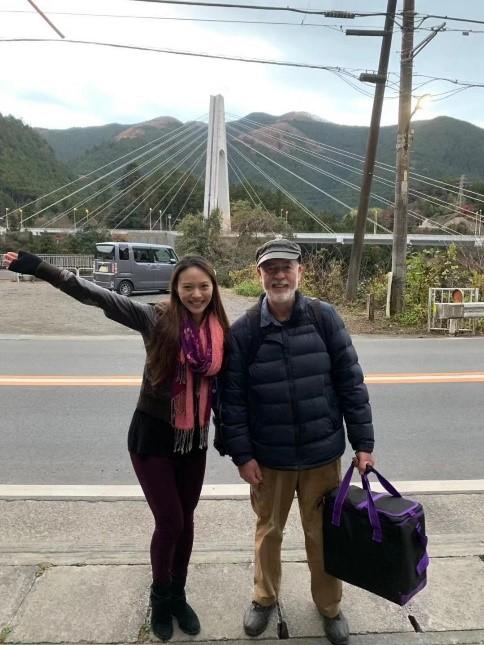
*~*~*
Some quick facts about wasabi:
ワサビについてのいくつかの簡単な知識:
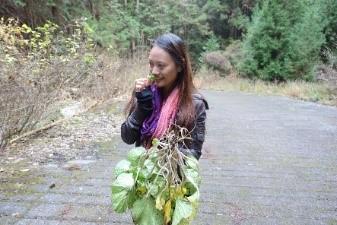
#1
- Historically, much of Tokyo’s wasabi is sourced from Okutama, a region famous for wasabi production. There are historical records of Okutama wasabi being presented as gifts to shoguns and their families during the Samurai-era.
- 歴史的に、東京のわさびの多くは、わさび産地で有名な奥多摩から供給されています。侍の時代、将軍とその家族献上される奥多摩わさびの記録があります。
#2
- Major production areas in Japan are currently in the rural mountainsides of Shizuoka, Nagano, Akita and Iwate prefectures.
- 現在、日本の主要生産地域は、静岡、長野、秋田、岩手県の農村山地にあります。
#3
- Wasabi (ワサビ or わさび (山葵, previously 和佐比)) is in short supply and it is difficult for many growers to meet the demand of consumers. In fact, the price per kilo is now upwards of $200 and increasing by up to 10% per year as demand continues to outstrip supply.
- ワサビ(山葵, 又は和佐比)は供給が不足しており、多くの生産者が消費者の需要を満たすことは困難です。 実際、1キロ当たりの価格は現在2万円以上上昇し、需要が供給を上回っているため価格が毎年10%ずつ上昇しています。
#4
- Due to its high cost, only high-end restaurants use fresh wasabi. A common substitute (the “wasabi” we commonly see in a tube) is a mixture of horseradish, mustard, starch, and green food coloring or spinach powder. In Japan, horseradish is referred to as seiyō wasabi (西洋わさび or “western wasabi”).
- 高価なため、新鮮なワサビを使用するのは高級レストランだけです。 一般的な代用品(私たちがチューブでよく見かける「わさび」)は、西洋ワサビ、マスタード、デンプン、および緑色の食用着色剤またはほうれん草の粉の混合物です。
#5
- Wasabi are grown on wasabida (山葵谷、or “wasabi patches”) often along stream beds in mountainous river valleys in Japan.
- わさびは、日本の山間部の渓谷の流域に沿って、しばしば「山葵谷」で栽培されます。
*~*~*
Hiking to the Wasabi Patch
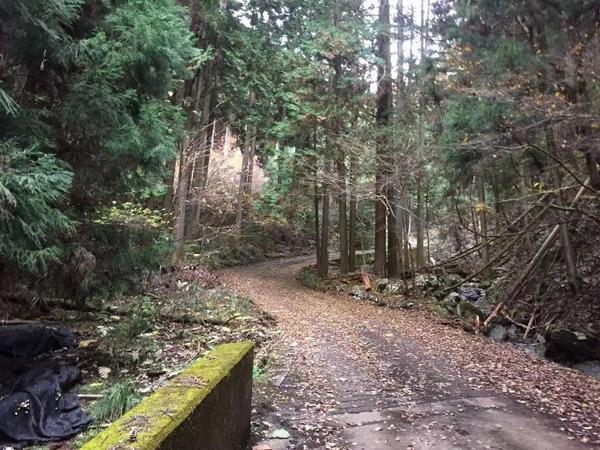
The wasabi plant grows naturally along stream beds in mountain river valleys in Japan. To reach the wasabi patch, you must first hike up the mountain. Tough work for wasabi growers tending to their patches!
日本の山脈の渓流に沿って自然に生長するワサビがあります。 山葵谷に到達するには、最初に山を登るのが必要ですよ! ワサビ栽培者が山葵谷を自然に見つけるのは結構大変ですね!
Wasabi plants are particularly difficult to cultivate. They are only found alongside rivers in mountainous terrains, using the water from the mountain streams. In addition, wasabi plants typically will not grow well if the water or air temperatures fluctuate too much (not below 8 degrees or above 20 degrees). As the water temperature in Okutama does not change much throughout the year, it is an ideal location to grow wasabi.
ワサビの栽培はとても困難です。山岳地帯の水を使って、山岳地帯の川沿いにのみ育ちます。 さらに、水や空気の温度があまりにも変動すると(8度以下または20度以上ではない場合)、わさび植物はよく成長しません。 奥多摩の水温は毎年あまり変わらず、ワサビを栽培するのに理想的な場所です。
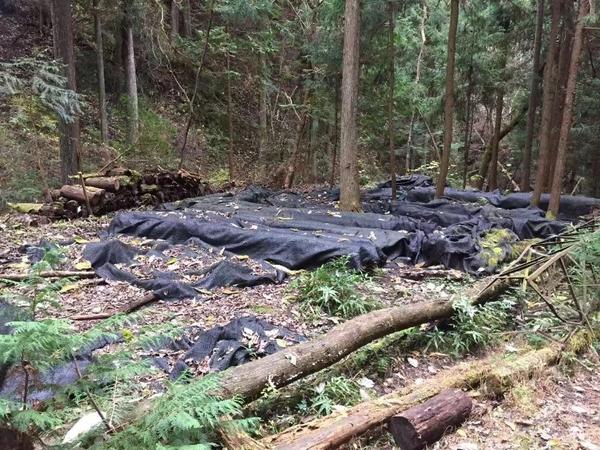
Various kinds of mushrooms are grown on dead logs up in the mountains near the wasabida.
山葵谷の近くの山々では、老木の上で様々な種類のキノコを栽培しています。
*~*~*
Arriving in the wasabi patch!
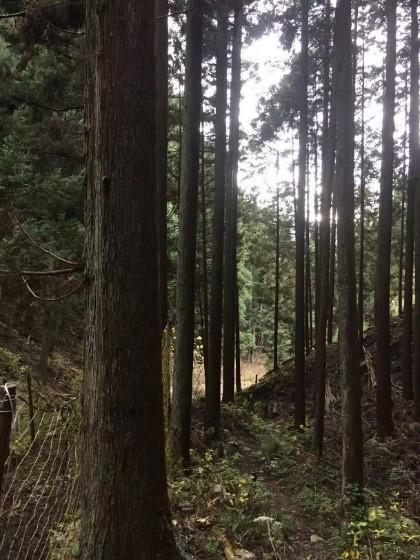
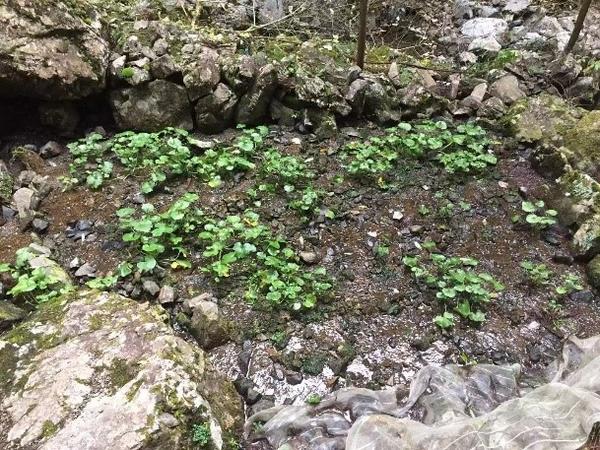
The roots of the wasabi plant need about a foot of good, though not too hard-packed, gravel and rocks and constant access to flowing water. The best water is spring water – the nutrients and minerals help the plants grow strong stems and have a direct impact on the wasabi flavor.
ワサビの根を、約1フィート伸ばすには良質な土壌と毎日水を流れていることが必要です。 最高の水は湧水です – 栄養素とミネラルは植物が強い茎をつくるのを助け、ワサビの風味に直接影響します。
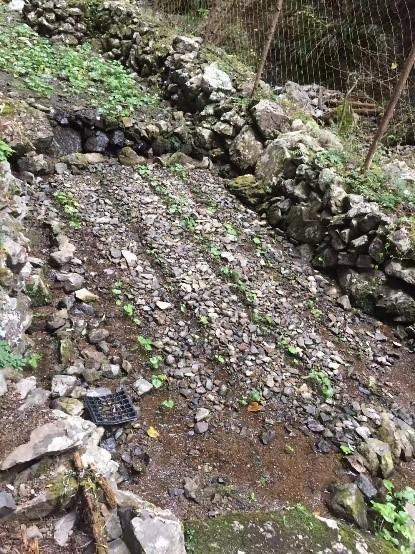
There are many different species of the wasabi plant and they fetch different prices! The two main cultivars in the marketplace are E. japonicum ‘Daruma’ and ‘Mazuma.’
ワサビは植物の多くの異なる種類があり、それぞれに異なる価格で売られます! 市場の2つの主な品種は「ダルマ種」と 「マズマ種」です。
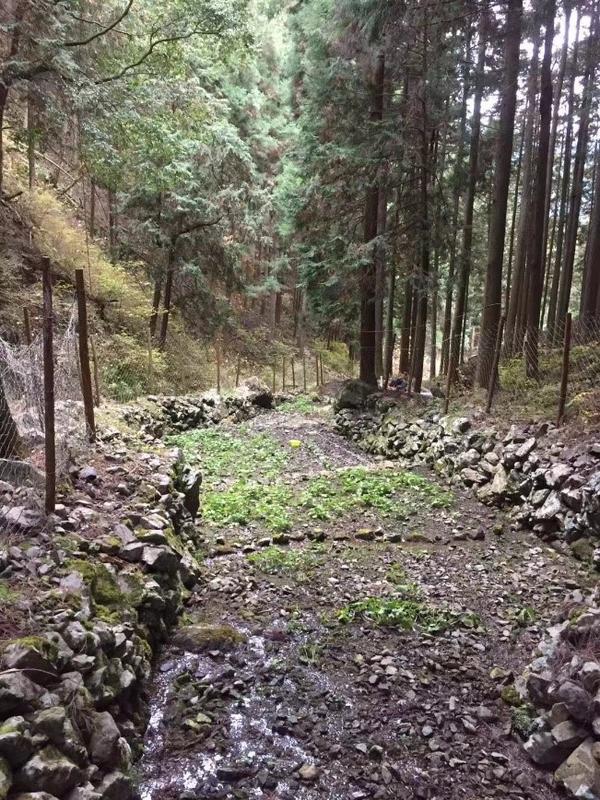
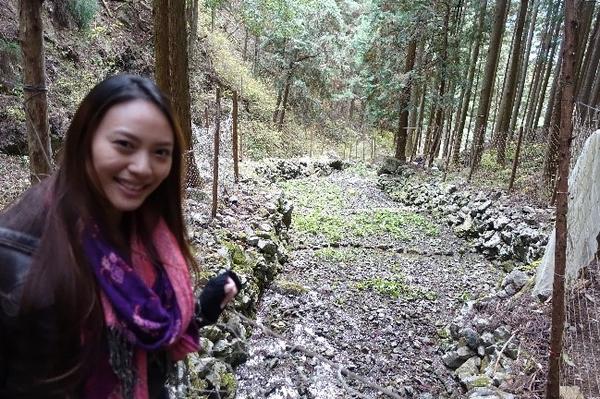
David’s wasabida has a history of over 100 years old. It was originally built by charcoal makers up in the mountains! David rents his wasabida from the land owner at only 3,000 yen (about USD$30) a year and grows about 1000 wasabi plants! I was surprised that the rental prices are so reasonable!
Davidの山葵谷は100年以上の歴史を持っています。 それはもともと炭の製造業者によって山に造られました! ダビデは土地所有者から山葵谷を年間3000円で借りて、約1000のワサビを栽培しています!賃貸価格がとても安価妥当であることに驚いきました!
*~*~*
Checking out the water source for David’s wasabi patch!
山葵谷のための水源を見に行きました!
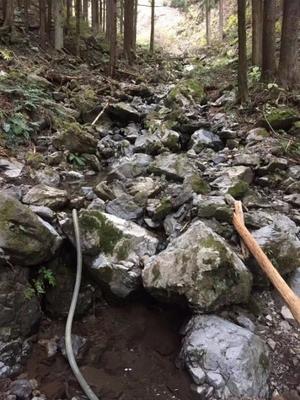
Similar to making good tofu and sake, it is quality water that is key to growing good wasabi! Dissolved minerals in water that has seeped through the mountains are what give flavor and pungency to wasabi, and as a result many growers will locate their wasabida near favorably tasting water sources.
良い豆腐と日本酒を作っているのと同じように、良いわさびを栽培する上で最も重要なのは高品質の水です!山々に浸透した水に溶けたミネラルは、ワサビに味と辛味を与えるものであり、その結果、多くの栽培者が山葵谷を水源の近くに好んで配置します。
*~*~*
Digging out wasabi plants
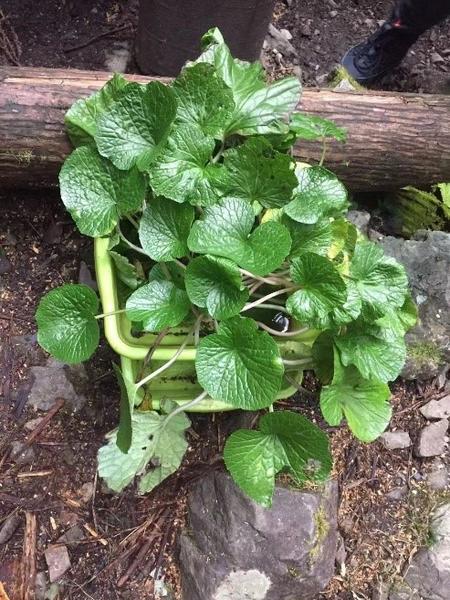
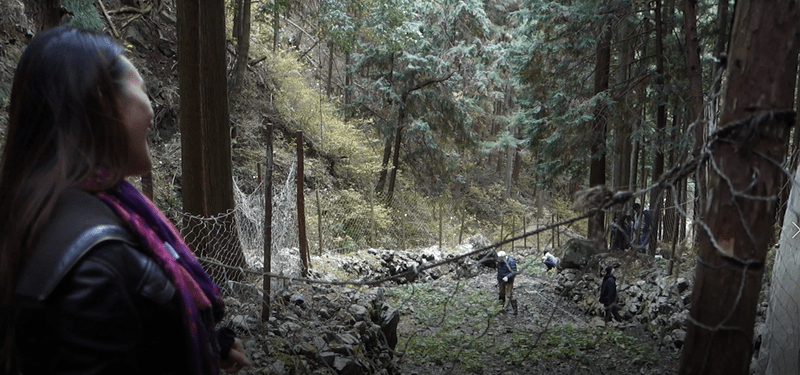
A wasabi plant generally takes about 18 months of careful cultivation to reach maturity (planted in April and harvested in October the year after). Growers must be very careful though because if the plant gets damaged, deprived of water or smothered by silt then the stem will begin decaying and turn black.
わさびの栽培には、一般的に約18カ月間の期間が必要です(4月に植えられ、次の年の10月に収穫されます)。 植物が傷ついたり、水分を奪われたり、沈泥物に覆われたりすると、茎が腐敗して黒くなってしまうので、栽培者は非常に注意する必要があります。
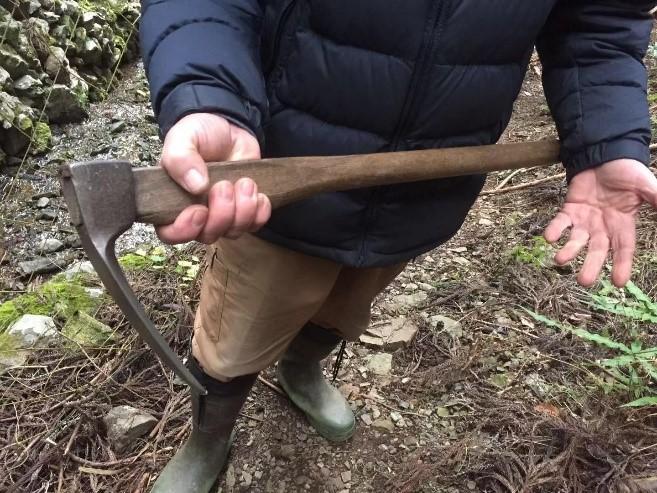
David uses the kazusa, a curved, slim, and sharp Japanese farmer’s hoe, to tend to his wasabida. The long steel tooth is designed for working riverbed stones.
彼は「カズサ」と呼ばれる湾曲した、スリムで鋭い日本の農家の鍬を使用して、育てています。 ロングスチールの先端は川床の石を加工するために設計されています。
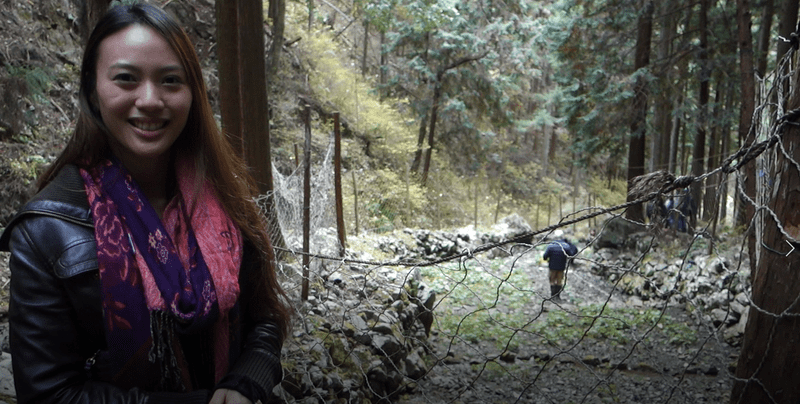
Watching David tend to his wasabi patch. There are 3 ways to grow wasabi – from seedling, sprout, and cloning. David and his wife attend the local wasabi juku (ワサビ塾, a kind of “cram school for wasabi growing”) where they engage in 15 or so field trips over an 18 month period (the full growing cycle of wasabi) learning how to cultivate wasabi from planting, to growing, and harvesting, together with other wasabi growers in Okutama!
わさびを栽培する3つの方法があります:苗木、芽吹き、および増殖。 Davidと奥さんは奥多摩の他のワサビ栽培者とともに、ワサビの栽培方法を学ぶのために18ヵ月を費やしている地元の「ワサビ塾」に通っています !
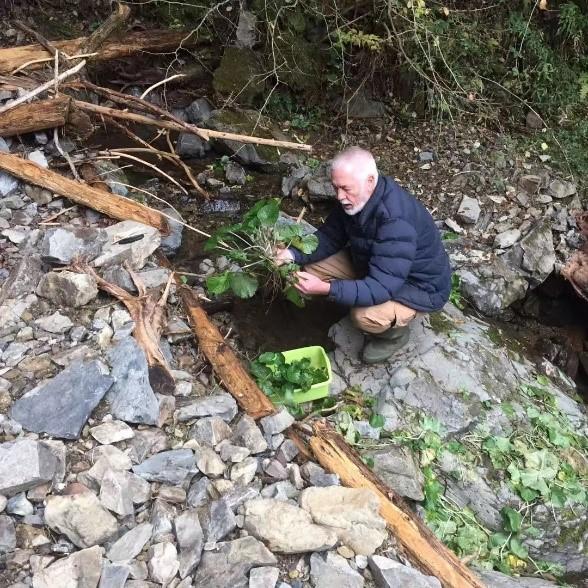
Eventually, David will use his kazusa to dig out several wasabi plants with lush, green leaves. We then helped with cutting off the leaves and cleaning the stems with knives made of deer antler, finally washing them off in the river water. Apparently, the leaves of the wasabi plant are also edible!
「カズサ」を使って、豊かに育ったいくつかのワサビを掘り起こします。 その後、鹿の角で作られたナイフで葉を切り、茎を掃除し、最後に川の水で洗い流しました。 どうやら、ワサビの葉も食べられるらしいよ!

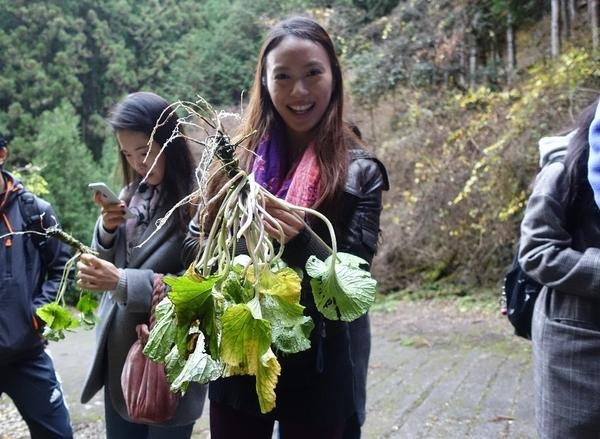
*~*~*
Tasting fresh wasabi plants!
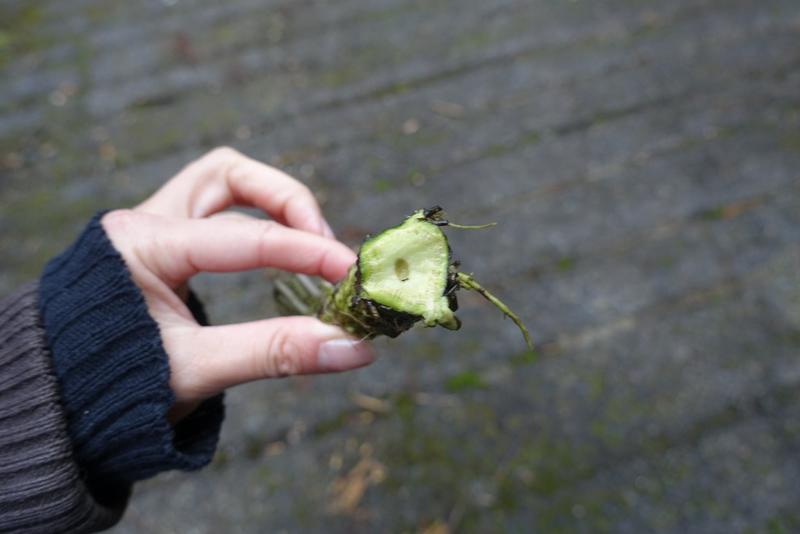
It is a common misperception that we eat the root of the wasabi. However, it is actually the stem that we grind and eat! In this way, wasabi is actually more similar to cabbages and broccoli than they are to ginger or other root vegetables.
私達が「わさびの根を食べる」と言われているのは誤いです。 しかし、実際に根ではなく粉砕されて食べられるのは茎です! このように、ワサビはショウガや他の根の野菜よりキャベツやブロッコリーの方に似ています。
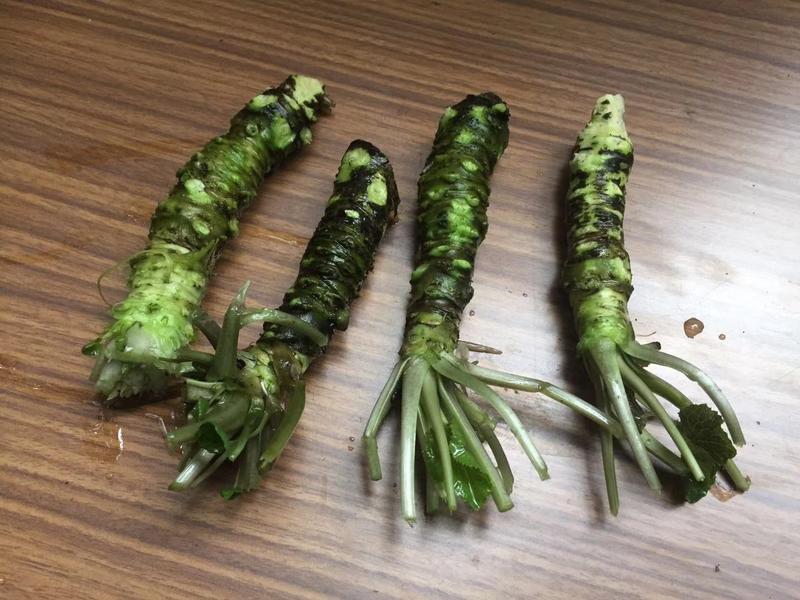
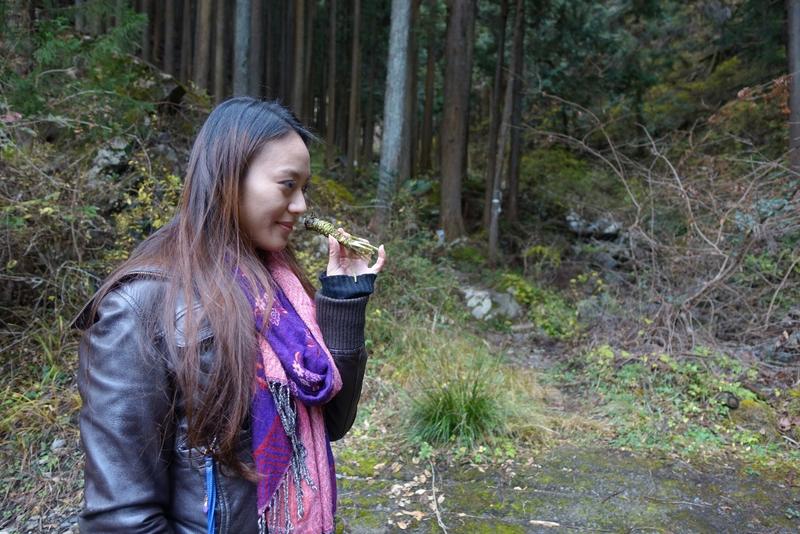
Real wasabi is not a green paste from a plastic package – it is the stem of the wasabi plant and tastes best when consumed soon after grinding! Specifically, freshly ground wasabi is the most flavorful around 1~3 minutes after grinding. After 3 minutes, the natural flavor begins to dissipate, and it is essentially gone after 15 minutes.
本物のワサビは、プラスチックに入った緑色のペーストではありません。ワサビの本物の味は茎にあり、すりおろした直後に食べるのが最高の味になります! 具体的には、すりおろした1分後が最も美味しいです。3分後は、自然の香りが消え始め、そして15分後にはほとんど消えちゃいます。
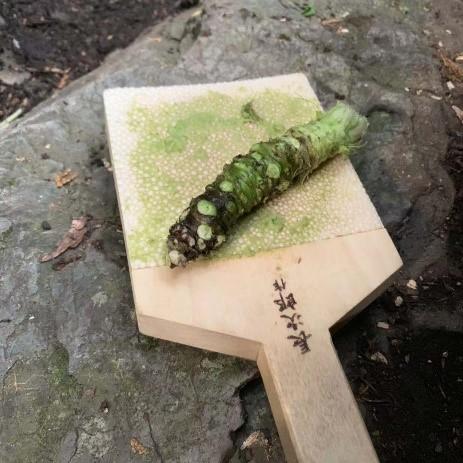
The best grinders for wasabi have a surface made of shark skin. The fresh wasabi served right after grinding has a refreshing sweetness and clean heat on the palate!
わさびのための最良のおろし器は、サメの皮で作られたものです。すりおろし直後の新鮮なワサビは爽やかな甘さと清潔な辛さがあります。
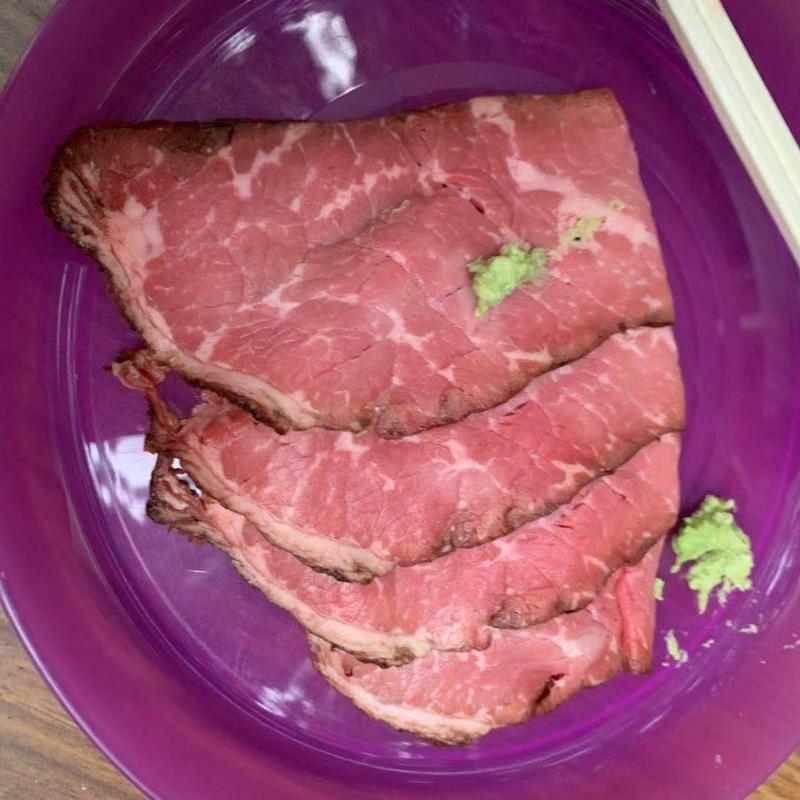
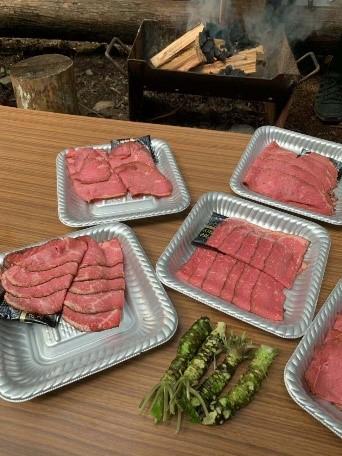
We got to share in some freshly ground wasabi with roast beef up in the mountains! Roast beef and freshly ground wasabi are a perfect combination.
ローストビーフと新鮮なワサビは完璧な組み合わせです。
| Read my interview with David Hulme as he shares his expertise! 続きましては、David Hulmeとのインタビューをご覧んでください! Link: https://scholar.harvard.edu/rachel_leng/blog/d.hulme |
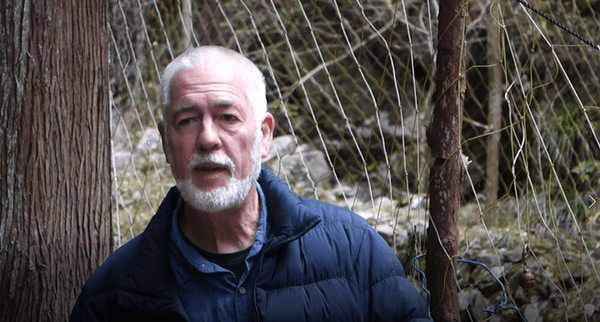
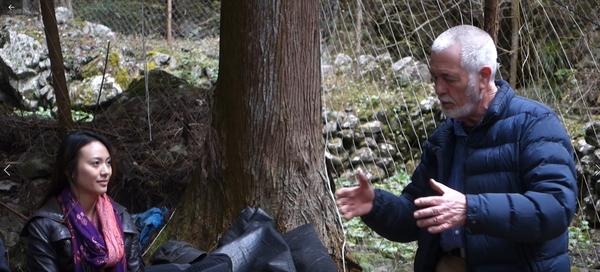
*~*~*
Final Thoughts || 最後の一言
I learned a lot about wasabi growing and Okutama’s appeal from David’s unique and insightful perspective. However, there is a looming concern about the lack of interest in wasabi growing from younger generations. Existing wasabi growers are getting older, and modern Japan is faced with the reality that their expertise in cultivating this cherished plant will soon be lost. For example, one of Okutama’s wasabi growers with the largest production volume (over 50,000 plants per year) is already in his 80s and has no one to take over. Deeply knowledgeable about wasabi, this farmer ensures that every single bit of his plants is used somehow, but his fields may soon fall into disuse with his retirement, further exacerbating the shortage of wasabi. This problem of aging farmers is consistent with the current state of Japan’s agricultural industry as a whole, as I most recently experienced during my visit to Fukushima to learn about the prefecture’s food value chain (read about my visit to “Yoshinoya Farm Fukushima” and “Asahi Brewery Fukushima”).
私は本当にDavidのユニークで洞察力のある視点から奥多摩の魅力について多くのことを学びました。しかし、今後若い世代がワサビに対する関心のないことを懸念しています。現存するワサビ栽培者は年を取っており、現在日本は、この大切な植物を栽培する後継者が少ないという現実に直面しています。例えば、奥多摩の最大生産量(年間5万株以上)のワサビ生産者の一人は、すでに80代に入っておりますが、引き継ぐ人はいません。寂しいですね…ワサビについて深く知っているこの農夫は、そろそろ引退するはずですが、山葵谷は使用できなくなる可能性が多くて、ワサビの不足をさらに悪化させると思います。このような高齢化農家の問題は、日本の農業産業全体の状況と同じかもしれません。私が日本の農業を知るために最近福島県を訪問した時、同じ社会問題に遭遇しました(「吉野家ファーム福島」と「アサヒビール福島」への私の訪問についてご覧ください)。
Perhaps the biggest obstacle facing wasabi growers is marketing. At the moment, wasabi growing is very hard work, but the low wholesale prices that farmers get compensated are nothing close to what consumers have to pay. Farmers are in financially vulnerable positions when they are unable to market directly to the end consumers. Unfortunately, there is not much information or public awareness about this matter. Perhaps applying “farm-to-table” and e-commerce business solutions would make the industry more lucrative by empowering wasabi growers with access to a bigger share of the market. Especially given that Okutama is so close to Tokyo, it might be the best place to start various initiatives that would boost the local industry. Making the wasabi industry more efficient would naturally also generate greater appeal and more opportunities for younger farmers to become wasabi growers. We can already see the beginning of the shift to online markets, as consumers take initiatives to buy fresh wasabi at better prices by searching online and ordering directly from the farms.
私から考えると、ワサビ生産者が直面する最大の障害はマーケティングの問題だと思います。 現時点で、ワサビの栽培は非常に難しい作業ですが、農家が補償する低い卸売価格は、消費者が支払うものに近いものではありません。 農家は、最終消費者に直接販売することができない場合、財政的に脆弱な立場にあると思います。 残念ながら、この問題についての情報や一般の認識はあまりないかもしれません。 多分、「農場間」およびE-Commerceのビジネスソリューションを適用することで、ワサビ生産者が市場のより大きなシェアを得ることができるようになり、業界がより収益を上げることになるでしょう。 特に、奥多摩は東京の中心に近いので、地場産業を活性化する様々な取り組みを始めることが最適かもしれない。 ワサビ産業をより効率的にすることは、当然のことながら、より若い農家がワサビ生産者になるためのより大きな魅力とより多くの機会を生み出すでしょう。
David’s passion to support the revitalization of Okutama is truly inspiring and opportune. Be sure to read his interview to hear from his insights! His pursuit of new projects such as initiating a wasabi seedling program or starting an e-commerce website and ideas for boosting the region’s forestry industry reflects critical changes in a traditional community. We should all look forward to his future contributions!
そういうわけで、Davidが奥多摩の活性化をサポートするための情熱は本当に勇気づけられて、そして今はチャンスの時です。 彼の考えを知るためにインタビューを必ず読んでくださいね~! ワサビ苗木プログラムの開始やEコマースウェブサイトの開設、地域の林業産業の向上のためのアイデアのような様々な新しいプロジェクトの追求は、伝統的なコミュニティにおける重大な変化を反映しています。将来を楽しみにしています!
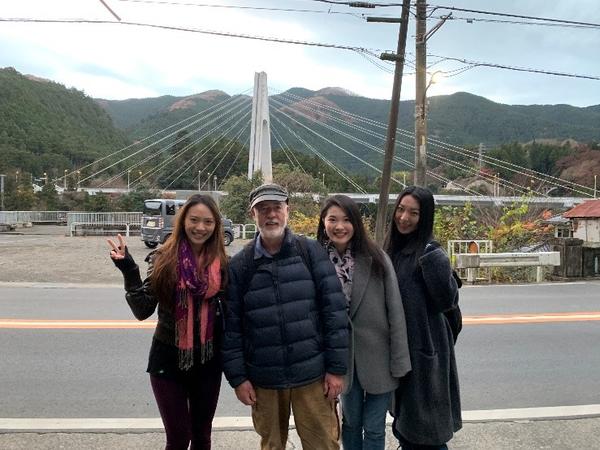
*~*~*~*
Read more about David’s experiences at


